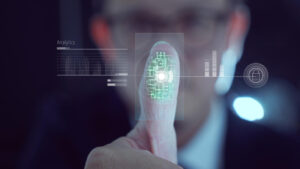An important development in this regard is to incorporate biometric technology into the Know Your Customer (KYC) process stated Bahaa Abdul Hadi. Biometric KYC is making customer onboarding faster, more secure and easier. This technology uses individual biological characteristics like fingerprints and facial recognition or retina scans to identify customers, doing away with the need for traditional documents and manual verification.
Speed and Efficiency of Biometric KYC
Biometric KYC makes customer onboarding much faster. The onboarding process in traditional KYC often involves collecting many different documents and can take days to several weeks. With biometric KYC, customers can identify themselves in real-time by mobile phone or other devices, so waiting takes only minutes or even seconds. This not only improves user experience but also allows banks to process more customers more quickly.
- Speed Onboarding: With biometric verification instead of manual checks, customers can quickly complete the KYC process without entering a bank. This simplifies opening accounts and applies for loans.
Security and Fraud Prevention
One of the greatest advantages of biometric KYC is that it is very secure. Biometric characteristics like fingerprints, facial features, are unique for each person They’re almost impossible to forge or steal. This reduces the risks of identity theft and deception That often accompany traditional KYC methods based on documents and passwords.
- Enhanced fraud prevention: By using biometrics to verify a customer’s identity, a bank can make sure that only legitimate customers get access to services. This aids in stopping fraud, unauthorized transactions and takeovers of an account.
Simplified Customer Experience
Incorporating biometric KYC into banking systems enhances the overall customer experience. Traditionally, the opening of an account or the verification of identity required customers to submit documents in person or by mail.
With biometric authentication, customers can complete the process from their own home using only their smartphones, which cuts down on surrounding friction that often accompanies manual methods of verification.
This convenience allows for higher customer satisfaction and a better relationship with their bank. The technology is intuitive and simple to use, so anyone can use it—even someone who doesn’t make regular use of computers or hi-tech devices.
How Biometric KYC Works
Biometric KYC typically involves a simple three-step process. First, the customer captures their biometric data, such as a facial scan or fingerprint. Next, the system compares this data to a secure, pre-registered database in order to confirm the customer’s identity. Once verified, the customer is able to access their account or service. The whole process only takes place in real time, making it quick and efficient for onboarding purposes.
The Future of Biometric KYC in Banking
Looking ahead, the future of biometric KYC in banking looks bright. As technology advances, heavy development efforts are going into making biometric technology faster, more accurate and able to reach many more people. The integration of artificial intelligence and machine learning will further improve the functions of biometric KYC, making it even more reliable and secure.
With greater acceptance, biometrics are likely to be accepted as the way of doing KYC processes across the entire banking industry, giving both banks and customers a better experience that is more efficient, secure, and user-friendly.
Conclusion
Biometric KYC offers a fast, secure, and seamless onboarding process. This technology not only enhances the customer experience but also enhances security and reduces fraud. As traditional banks rapidly embrace biometric KYC, we can expect a banking environment safer, faster, and more customer-friendly all around the world. The article has been written by Bahaa Abdul Hadi and has been published by the editorial board of Identity Herald. For more information, please visit www.identityherald.com.




